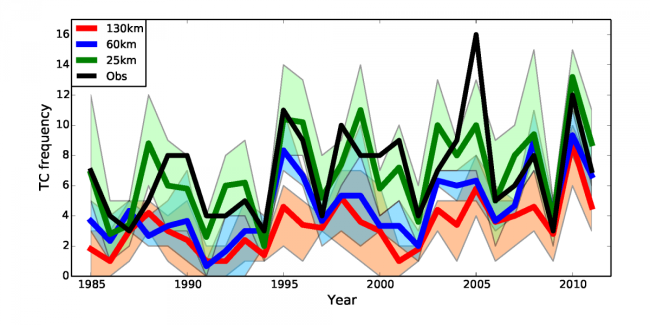High-resolution climate models show skill in hurricane variability
Climate extremes such as hurricanes and typhoons can cause death and destruction for communities around the world. Scientists as part of the US CLIVAR Working Group on Hurricanes are interested in studying both the predictability (such as on multi-year timescales) and possible future changes in the frequency and intensity of such storms.

A hierarchy of models, ranging from typical climate resolutions using grid cells with 130km sides to resolutions more often found in weather forecasting models with 25km sides, have been used to study the impact on simulated tropical cyclone performance. In common with other studies, this paper finds that the higher resolution models are able to simulate observed interannual variability with considerable skill in basins such as the North Atlantic and Northwest Pacific. Part of the cause for this in the Atlantic seems to be due to interacting processes over Africa creating more structures from which hurricanes can grow.
In the future projection for 2100, there is a reduction in the frequency of these events by about 50% in the Southern Hemisphere, with changes in the Northern Hemisphere more varied. For example, the North Atlantic has less activity while the Pacific sees shifts in where the events happen, with increases occurring around Hawaii and the Central Pacific. One problem with the model used in the study is that the simulated storms have weak winds compared to the observations, which makes it difficult to say whether future storms are likely to become more intense or not in a warmer world.
Tropical Cyclones in the UPSCALE Ensemble of High-Resolution Global Climate Models* (Journal of Climate)
1Met Office Hadley Centre, Exeter, United Kingdom
2National Centre for Atmospheric Science, Department of Meteorology, University of Reading, Reading, United Kingdom
3Willis Research Fellow, Knowledge Transfer Partnership, University of Reading, Reading, United Kingdom
4Natural Environment Research Council Centre for Earth Observation, University of Reading, Reading, United Kingdom
5Department of Meteorology, University of Reading, Reading, United Kingdom
Topics
- Hurricane
- Extreme Events
